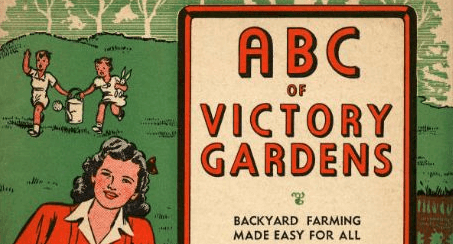The Victory Garden- Alternative Growing Methods
If a large garden plot just doesn’t work for your particular family size or gardening ability, there are plenty of other options for you to grow your own Victory Garden on a smaller scale.
So let’s consider containers. Just about every vegetable can be grown in a container. This includes ceramic pots, galvanized tubs, window boxes, five-gallon buckets, fabric grow bags, or any number of other vessels. For those who have difficulty with the bending and lifting involved in a traditional garden, or even with containers, there are also gardening tables. This invention is brilliant for anyone with back issues or for those gardeners who may not be able to stand for long periods. Gardening tables are the perfect size and height and have an open bottom to allow a chair to slide underneath to give you 360-degree access to the soil. And for those gardeners who may not have any access to soil, or who want to grow indoors, hydroponics may be the way to go!
An important consideration is also what your vessel is made of. Terra cotta pots for example will pull moisture out of the soil quickly because they are porous, glazed pots will lose moisture more slowly as water drains through the bottom holes. Galvanized tubs will heat up quickly and bake your soil.
The most important thing to keep in mind when making your selection is to put the right plant in the right container. As we discussed in a previous post, different vegetables have different needs as far as growth and nutrition. Long season, heavy feeders like tomatoes require a large, deep container. Root systems need space to branch out, stabilize the plant, and take up nutrients. If your container is too small for adequate root growth you will have a stunted, sickly plant that won’t produce fruit. Lettuce, as another example, is a short season light feeder, which would be perfectly happy growing in a smaller container as it has a much smaller root system and does not require as many nutrients to grow well.
The next thing to consider is soil. Unlike traditional gardening, growing in free-standing containers requires a little more attention to detail. The nutrients in containers will deplete more quickly through daily watering and natural uptake by the plant. Trace nutrients, beneficial bacteria, and worms that are found below the ground don’t exist in most container soils. Even the best, most expensive bagged soils will lose their nutrients over time so it’s important to replenish them when needed throughout the season.
Research bagged soils carefully. Be sure the one you choose does not contain any synthetic fertilizers which are not recommended for vegetables. Look for soils that contain compost or manures. If these are not available, buy a bag or two separately and mix your own blend. Just as in creating a raised bed, container garden soil also need the ability to drain excess water but retain moisture, as well as being light enough to aerate roots.
And finally a word about hydroponics! Truly, this subject will deserve a post all to itself due to the wide range of growing systems, but for basic principles, hydroponic growing can be as simple or as complex as you want to make it. The most simplified system is called the Kratky Method which involves nothing more than a deep container to hold water, a lid, a net pot, soilless growing media to stabilize the plant and nutrients. If you were to use this method, and your vessel of choice is five-gallon buckets, then your growing space needed would be approximately the same as if you were growing with soil in containers. The biggest difference is in the soil or lack thereof. Because you are growing in water, your plants will not have access to the naturally occurring microbes and bacteria in the soil. All of the nutrients they need will only come from what you add to the water. There is a little more science involved with hydroponics but once you understand the basics you can grow just about any vegetable with this system. Another huge benefit to hydroponics is its versatility. Whereas vegetable plants may struggle to grow in soil indoors, hydroponically grown vegetables do quite well with the right indoor conditions.
Growing a Victory Garden planter is not impossible but it will take planning and thought. With limited space, you may want to think about which vegetables are most worthwhile to grow and preserve. For example, if we consider greens, the price per pound for kale at the grocery store is much less than the cost of spinach. Both freeze quite well but, with limited space, you may want to choose to grow spinach instead.
It’s also wise to think about crop rotation which is just as important in containers as it is in the ground. If you are growing a spring broccoli plant which is a heavy feeder, follow it after harvest with a leaf lettuce or green beans. The same rules apply to containers as they do in a traditional garden plot and we will cover that in an upcoming segment.
As you can see, there really is no limit to the options of Victory Gardening in containers. Use your imagination and you’ll fill that larder in no time!

